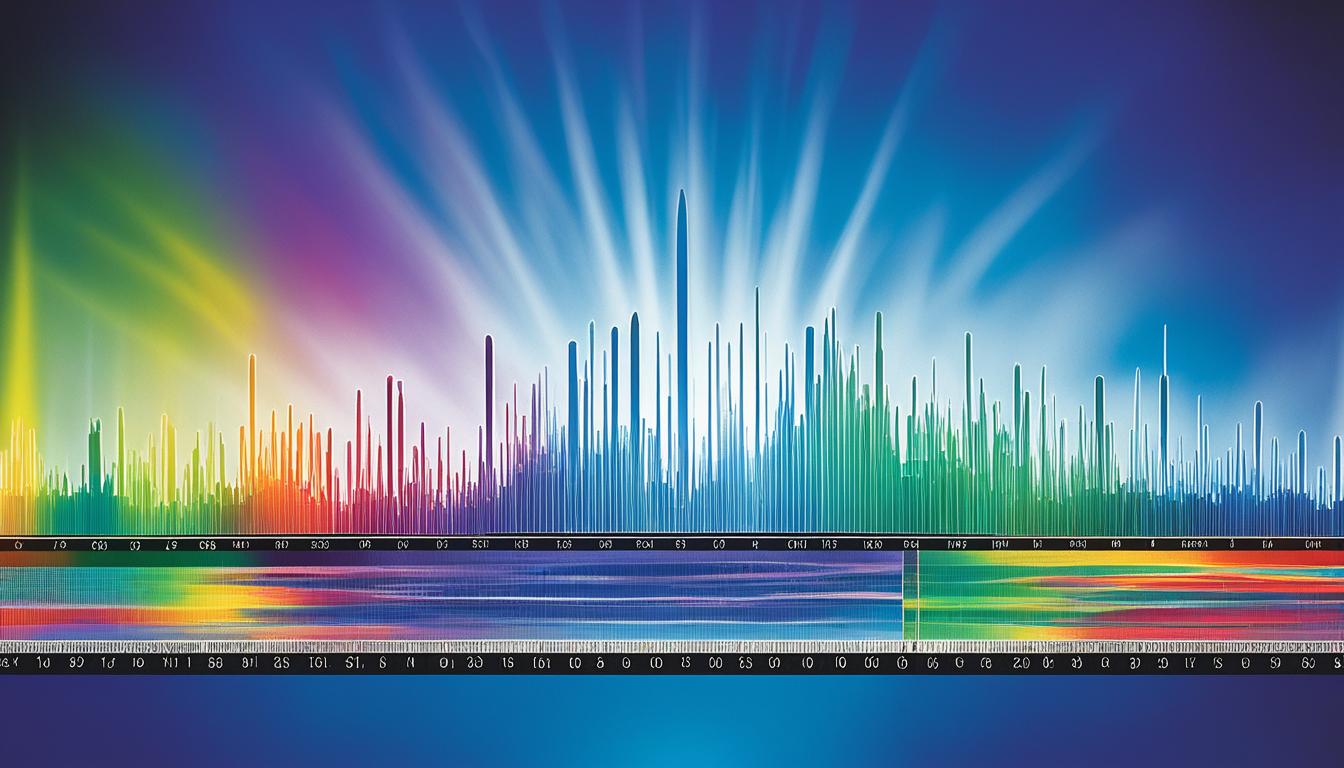Disclosure: This Post Contains Affiliate Links; We earn a commission on purchases.
Within the realm of electromagnetic radiation lies a lesser-known spectra known as ELF, or Extremely Low Frequency radiation. As a variance of electromagnetic fields commonly produced by power lines and electrical appliances, ELF permeates our environment with frequencies that range from a subtle 1 Hz to a modest 300 Hz. Though frequently encountered in daily life, ELF has managed to retain an air of enigma, prompting studies to unravel its potential health implications and standards to gauge its safe usage.
Given the ubiquity of ELF sources, the importance of understanding this electromagnetic radiation extends beyond scientific curiosity—it brushes against the canvas of public health and occupational safety. Despite the absence of specific OSHA standards tailored for ELF, its inclusion in broader electrical and magnetic field safety protocols underscores the critical need for continuous examination and prudent exposure management.
Key Takeaways
- ELF refers to Electromagnetic Radiation with frequencies between 1 Hz and 300 Hz.
- Sources of ELF include everyday utilities such as power lines and electrical appliances.
- Potential health impacts of ELF radiation have spurred epidemiological studies and safety program integrations.
- Global frequency classifications by entities like ITU and WHO guide ELF radiation guidelines.
- The lack of OSHA-specific ELF standards necessitates broader safety protocols in workplaces.
What is ELF (Extremely Low Frequency)?
At the most foundational level of our technologically charged atmosphere lies a spectrum known as Extremely Low Frequency (ELF) waves. These invisible wriggles in the electromagnetic field permeate through the expanse of our day-to-day lives with an unassuming presence that is both frequent and ordinary—an electromagnetic whisper between 1 and 300 Hz, scarcely audible to the instruments of scientific inquiry, yet substantial enough to merit investigation and understanding.
As integral threads in the vast tapestry of the electromagnetic spectrum, ELF waves represent a ballet of frequencies that dance just beneath the threshold of human perception, encapsulated within the non-ionizing segment of radiations where their energy insufficiently liberates electrons from atoms, thus painting them as ostensibly benign to biological cohorts. Yet, this is not the entire narrative.
The study of ELF waves stretches beyond their simple existence; it probes into the realms of how these undulating currents of alternating fields influence the sprawling networks of power lines and electric appliances that compose modern lives. It questions how non-ionizing radiation ensconced in ELF modulates the complex mechanisms within our bodies, and it challenges the thought that such a pervasive aspect of our environment might oscillate without consequence.
Defining ELF Radiation
The International Telecommunication Union (ITU) earmarks the spectrum of ELF radiation to ensnare frequencies from a ponderous 3 Hz to an equally lethargic, albeit somewhat livelier, 30 Hz. This sliver of the spectrum translates into wavelength counterparts that majestically stretch across tens, if not hundreds, of thousands of kilometers. Naturally occurring phenomena such as lightning strikes and the undulations within Earth’s geomagnetic domain birth ELF waves, making these forces of nature not just meteorological interests but concerns within the magnetosphere.
Electromagnetic Spectrum and Non-Ionizing Radiation
Positioned within the broader electromagnetic spectrum, ELF waves coexist with other forms of non-ionizing radiation, generating a magnetic field therapy that prods the body with levels of energy too low to break chemical bonds. This gentle nudge stands in stark contrast to their ionizing kin, whose potent energy thrives on creating charged particles by forcefully tearing electrons from their atomic orbits. Unlike ionizing radiation’s unequivocal narrative of health risks, ELF waves talk in muted tones of bioeffects, hinting at biological interactions where definitive implications for human health continue to be a subject of ongoing research and debate.
Alternating Current Fields and ELF
In the modern world, where electricity is the invisible lifeblood that powers progress, ELF radiation emerges as a byproduct of civilization—born from the alternating current (AC) fields that run wild and free through power lines and electrical devices. With such ubiquity, a non-negotiable necessity arises: the assessment of ELF exposure. To safeguard the collective wellbeing amidst these persistent waves, efforts continue unabated to understand and regulate the subtle impacts that these alternating current fields may impose on the unsuspecting human form.
Such an assessment seeks not just to describe, but to prescribe—to determine safe levels of exposure and foster the development of ELF safety protocols that are sound, scientifically grounded, and imbued with a concern for both occupational and public health.
Embarking on this electromagnetic odyssey, one must remain cognizant of the fact that while not all that glitters is gold, not all that hums harmlessly through our wires and air is negligible in its effect. The journey of untangling the mysteries of ELF radiation is, indeed, an ongoing quest that hums with a frequency all its own—one that resonates with the chords of curiosity and caution.
Global Standards and Safety Measures for ELF
Within the broader ambit of workplace and environmental safety lies a nuanced domain that encompasses the ever-present yet intangible phenomena of Extremely Low Frequency (ELF) electromagnetic fields. Despite their persistent resonance through the fabric of our daily lives, ELF fields fall into a regulatory grey area with respect to specific safety legislation. It’s within this context that bioelectromagnetics, an interdisciplinary field that explores the interaction of biological systems with electromagnetic fields, gains significant relevance.
A closer look at the existing framework reveals a notable omission: when it comes to Occupational Safety and Health Administration (OSHA) protocols, there is currently no tailor-made standard that addresses ELF safety programs directly. However, the safety and well-being of individuals in environments with notable ELF presence are not left unattended. Instead, the data gaps are bridged through broader safety measures that oversee non-ionizing radiation as a whole.
No Specific OSHA Standards
While OSHA has not set forth explicit criteria for ELF exposure, its wider radiation safety programs are implicitly tasked with ensuring that employees are shielded from any potential hazards. Indeed, organizations and businesses are beckoned to heed the call of due diligence, incorporating strategies for ELF exposure assessment into their overarching health and safety plans.
This cautious approach is partly necessitated by the uncharted waters we navigate regarding the definitive impact of ELF fields on human health. In this way, companies are encouraged to adopt proactive ELF safety programs, overlaying a safety net to protect against unseen risks in electromagnetic wave exposure.
International Guidelines and Protocols
The characterization and regulation of ELF fields extend beyond domestic borders, harmonizing with global efforts led by esteemed international entities. The International Telecommunication Union (ITU) and the World Health Organization (WHO), among others, collectively endorse a standardized definition and classification for ELF electromagnetic fields, each delineating associated frequency range clauses. Their alignment on this front consolidates the foundation upon which safety guidelines and recommendations are built.

NASA and WHO champion these broader guidelines, accentuating the unique attribute of ELF fields wherein their lengthy wavelengths manifest in independent behaviors of electric and magnetic components; necessitating autonomous measurement techniques. This acknowledgment by world-renowned agencies fortifies the edifice of understanding ELF fields and invites a concerted global response to detecting, evaluating, and mitigating ELF exposure.
The concert of international standards and protocols translates into a suite of practices that govern ELF interactions. These practices range from the determination of safety thresholds and exposure limitations to the establishment of ELF safety programs that strive for the minimization of health risks from bioelectromagnetics. Thus, the fabric of global standards and safety measures for ELF continues to be interwoven with meticulous care, thread by thread, safeguarding against the unseen, and upholding the tenets of public and occupational health.
Health Implications of ELF Exposure
Exploring the labyrinth of electromagnetic field exposure and its potential health implications is an ongoing scientific endeavor. Extremely Low Frequency (ELF) fields, despite their relatively low energy, have become a key focus of research due to their prevalence in human environments. Current data provide a multifaceted view of how ELF fields could interact with biological systems, encompassing both the potentially harmful bioeffects and therapeutic benefits.
Epidemiological Studies on Cancer Risks
While epidemiological studies have extensively explored the relationship between ELF field exposures and cancer risk, the results remain inconclusive. A diverse assortment of research suggests a correlation, particularly regarding the long-term exposure to magnetic fields generated by power lines. Still, the absence of unanimity in findings illustrates the intricacy of decipering ELF radiation’s health effects.
Effects on Human Physiology and Bioeffects
Aside from cancer risks, research into ELF exposure unveils a spectrum of physiological effects ranging from subtle to more discernible. Laboratory studies utilizing animal models have noted modifications in lipid metabolism and the induction of oxidative stress following ELF exposure, signaling that these low-frequency waves can indeed mediate change within living organisms.
“ELF electromagnetic fields, while imperceptible, could potentially influence biological processes such as lipid metabolism and oxidative stress, necessitating a thorough investigation into their long-term health implications.”
Magnetic Field Therapy and its Benefits
Contrasting with concerns over ELF exposure, magnetic field therapy harnesses these electromagnetic fields for therapeutic purposes. Pulsed ELF treatments have demonstrated health benefits by reducing cholesterol and triglyceride levels in cardiovascular disease models. These findings endorse the dual nature of ELF, possessing both risk potential and beneficial applications.

Moving forward, it is essential to broaden our understanding of ELF fields through rigorous, continuous research. Coherent, evidence-based guidelines and heightened public awareness will be pivotal in navigating the complexities associated with ELF exposure. With balanced scrutiny and innovative application, the narrative of ELF’s impact on health continues to unfold.
| ELF Exposure Type | Associated Health Effect | Study Reference |
|---|---|---|
| Power-frequency magnetic fields | Potential increased cancer risk | Epidemiological studies |
| Laboratory ELF EMF | Altered lipid metabolism, Oxidative stress | Animal model research |
| Pulsed ELF field therapy | Reduced cholesterol and triglycerides | Cardiovascular health models |
To responsibly harness the characteristics of ELF exposure, a path paved with discernment and scientifically informed measures is essential. Whether considering the potential for human health effects or the promising aspects of magnetic field therapy benefits, the journey towards understanding and integrating ELF fields into our lives is a dynamic and multifaceted endeavor.
ELF in Communication: Military and Submarine Uses
Delving into the depths of military communication, one encounters the pivotal role of ELF waves. Designed to conquer the challenge of oceanic depths, ELF communication emerges as the robust thread connecting surface commands to the stealthy world of submarines. The utility of ELF waves in this domain is underscored by their unique capability to penetrate the dense medium of seawater—a feat unattainable by higher-frequency radio waves that are readily absorbed or scattered.
The Role of ELF Waves in Submarine Communication
In the silent world beneath the waves, submarine communication epitomizes strategic discretion, where ELF transmission plays a starring role. Due to the low attenuation of ELF waves, they suffuse through water, allowing for the transmittal of critical instructions to submarines, paving the way for unseen coordination and operation. This application of ELF in military strategy is not only a testament to human ingenuity but also a crucial factor in the safety and effectiveness of naval forces.
Operational ELF Systems and Historical Context
Historically, nations investing in security and tactical communication infrastructure have established strategic ELF transmitter facilities. From the sprawling grounds of the U.S. Navy’s Wisconsin facility to similar installations in Russia, India, and China, these sites have been harnessed to deliver commands to the submerged fleets. Although some facilities, like the Clam Lake site, may have been decommissioned, the blueprint they created for military ELF transmitters remains integral to modern naval communications. As these waves of communication ripple invisibly under the oceans, they continue to be a potent, indispensable asset for defense and coordination beneath the sea.
Source Links
- https://en.wikipedia.org/wiki/Extremely_low_frequency
- https://www.ncbi.nlm.nih.gov/pmc/articles/PMC2203969/
- https://www.osha.gov/elf-radiation

Subscribe to Our Newsletter










